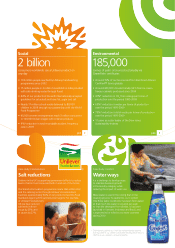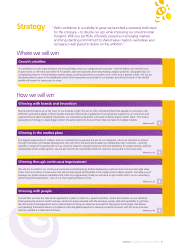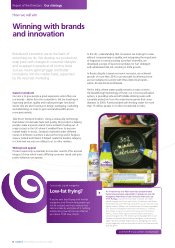Unilever 2009 Annual Report Download - page 14
Download and view the complete annual report
Please find page 14 of the 2009 Unilever annual report below. You can navigate through the pages in the report by either clicking on the pages listed below, or by using the keyword search tool below to find specific information within the annual report.
Win with winning customers
There is a growing trend in the retail industry towards consolidation,
with fewer but larger retailers. Thanks to our global scale and
local knowledge, Unilever is ideally placed to help those customers
achieve their own growth ambitions.
In 2008 we opened in New Jersey the rst of a network of
customer insight and innovation centres to work directly with
retailers. The centre covers everything from merchandising and
store layout, to displays and packaging. Through the centre,
we work with customers to design and test concepts without
going to the expense of real in-store pilots. Since opening,
the centre has generated significant growth opportunities. Our
London centre has since opened and we plan to open three
more in 2010 in Paris, Shanghai and São Paulo.
Be an execution powerhouse
Market development and great relationships with customers
will only be points of advantage if we execute with excellence.
This is not a complicated concept. It is about the everyday
disciplines of ensuring that we are delivering to our customers
the products they want, in the quantities they ordered at the
time they are needed. This involves having a customer-focused
approach across our brand building, customer development
and supply chain teams.
During 2009 we focused much more closely on ‘sales
fundamentals’, a set of company-wide measures covering every
aspect of our in-store presence. We have performed well against
these measures, which have been one of the many drivers in
improving customer service in most of our key countries.
The detail of what works in one type of store won’t work
for all, however. A superstore in the US is very different from
a local retailer in a small town in China, both in terms of the
products it carries and the way those products are sold. But for
each type of store, by channel and geography, there is a perfect
concept – namely, what the shop would look like if it were the
perfect sales vehicle for our categories and brands.
We developed the perfect store concept in the AAC region
(Asia, Africa and Central & Eastern Europe) in early 2009. We
began implementing it in modern trade outlets across the region,
focusing on the region’s largest four categories – skin cleansing,
hair, fabric cleaning and tea. In some smaller outlets, we even
succeeded in executing the transformation overnight, taking
the competition by surprise and maximising the impact of
the change.
Over the next few years our aim is to continue implementing
the perfect store concept across the AAC region, while in the
coming year, the concept is being rolled out around the business.
In developing and emerging markets, most people still make tea from loose leaves. There
is a huge opportunity to convert consumers to tea bags and, as the world’s largest tea brand,
Lipton is well placed to lead this development. In 2009, helped also by innovations in fruit
teas, Lipton grew by 7.4% across the world. With many markets only just beginning to wake
up to tea bags, we believe there is plenty of opportunity for further growth.
and more @ www.unilever.com/lipton
Case study: Lipton
Trading up with the world’s
most popular tea brand
Increasing the value of Lipton, the world’s most popular
tea brand, is all about conversion – partly conversion
from some other drink to tea, but also from loose-leaf
tea up the value chain through different types
of tea bags.
Coffee ice cream dream
Unilever is gaining momentum
in the North American ice
cream market with a
partnership to produce an
own-brand super-premium
ice cream for Starbucks.
Unilever Annual Report and Accounts 2009 11
























